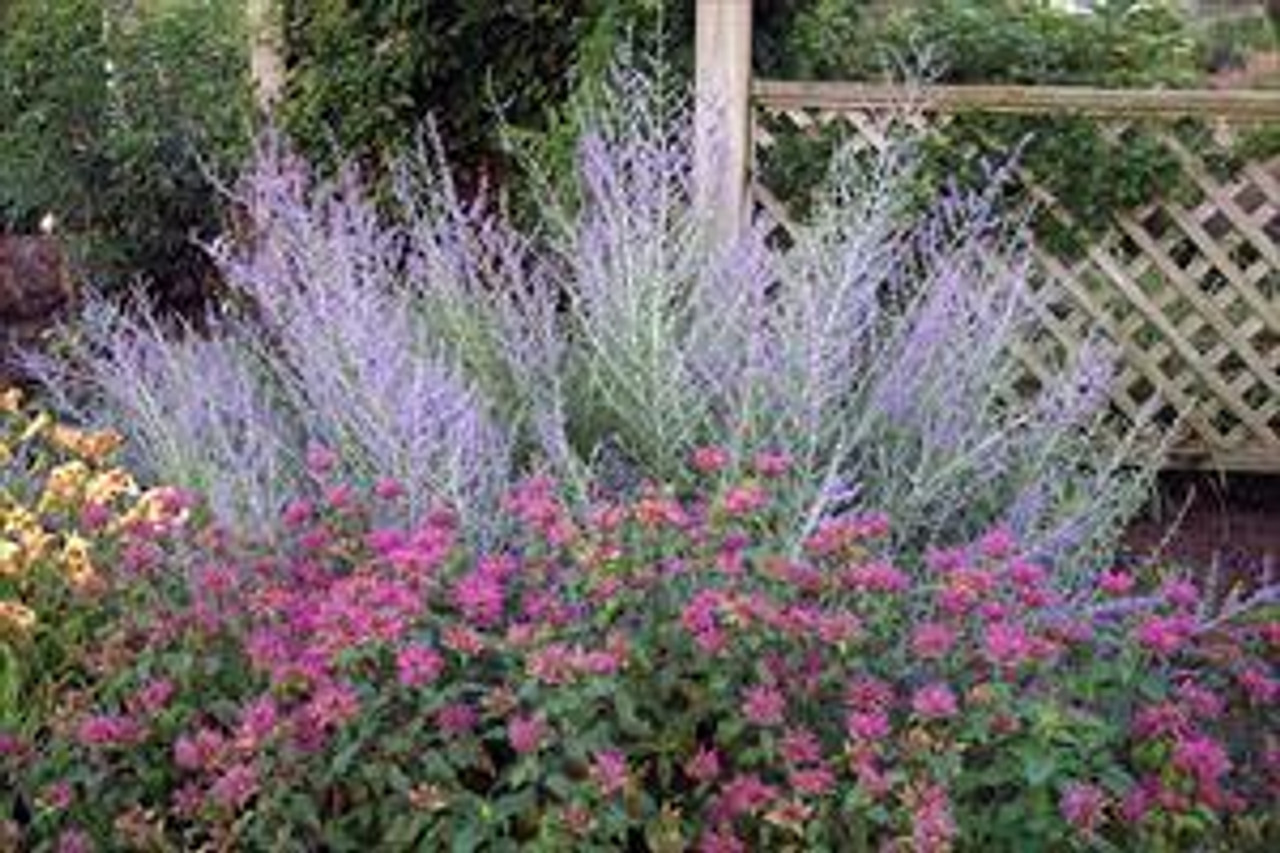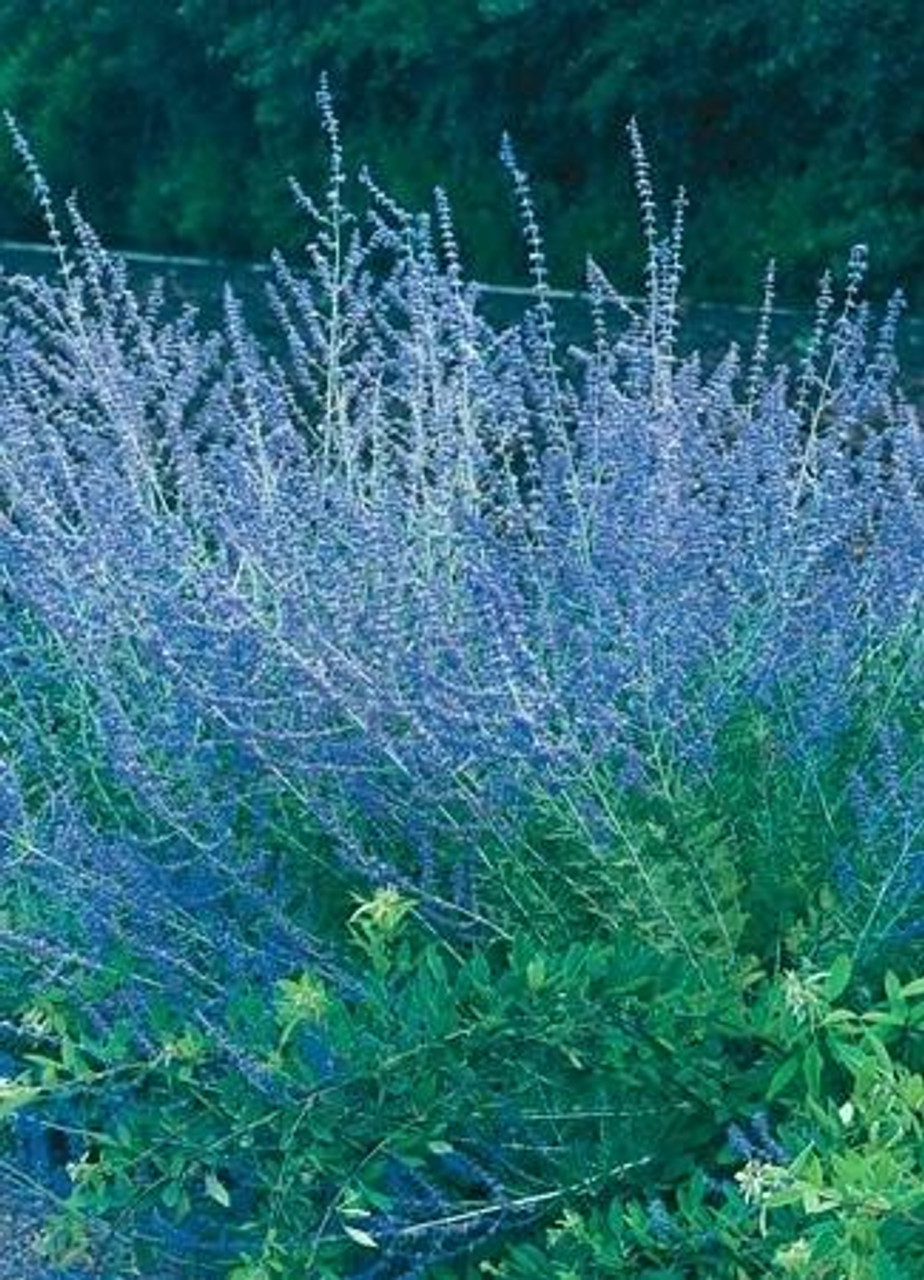Product Description
Perovskia atriplicifolia (25) Bare Root Plants
Family: Lamiaceae/Labiatae (mint Family); Common name: Russian Sage.
Airy spikes of lavender-blue, tubular flowers top strong stems with small, finely dissected, silvery-green leaves provides two or three months of flowers in late summer and autumn. Its loose, open habit makes this perennial an effective filler in the back of the border.
A perfect perennial for hot, dry climates and also exceptionally cold hardy. Perovskia can be used in a wide variety of environments with little attention through the season - a reason they have long been a staple of landscapers. Expect these plants to be a little later to emerge in spring, but also to offer color well into fall.
1995 Perennial Plant Association Plant of the Year!
Height: 36.0-48.0 Inches
Spread: 20.0-30.0 Inches
Hardiness Zones: 4,5,6,7,8,9
Flower Color: Purple-blue shades
Foliage Color: Green shades
Full Sun (> 6 hrs. Direct Sun)
Low t0 Average Water Needs
Poor to Fertile Soil Quality
Bloomtime: Late Summer - Mid Fall
Attracts Hummingbirds
Deer Resistant
Seasonal Interest: Dried Seed Heads
Growth Rate: Medium
Border Plant, Cut Flower, Cut Foliage, Dried Flower, Drought Tolerant, Easy To Grow, Fragrant Flowers, Fragrant, Foliage, Mass Planting, Salt Tolerant, Perovskia atriplicifolia's foliage appeal continues through winter.
Perovskia atriplicifolia, commonly known as Russian sage, is a beautiful and versatile plant that adds a touch of silvery-blue elegance to gardens. Here is what you need to know about it:
Appearance:
- Flowers: It produces masses of small, lavender-blue flowers that are arranged in airy, branched panicles. These blooms appear from mid-summer to fall, providing a long-lasting display of color.
- Foliage: The plant features finely dissected, aromatic, gray-green leaves that have a soft, fuzzy texture. The foliage releases a sage-like scent when crushed, hence the common name "Russian sage."
- Stems: It has upright, silvery-gray stems that add to its overall aesthetic appeal.
Growing Conditions:
- Hardiness Zones: It thrives in USDA hardiness zones 4 to 9, making it adaptable to a wide range of climates.
- Sunlight: It prefers full sun, which means at least 6 hours of direct sunlight per day.
- Soil: It requires well-drained soil and is tolerant of various soil types, including sandy, loamy, and clay soils. However, it is crucial to avoid waterlogged conditions.
- Water: Once established, it is drought-tolerant and requires minimal watering. Overwatering can lead to root rot.
Care:
- Fertilizing: It generally does not require heavy fertilization. A light application of a balanced fertilizer in spring is sufficient.
- Pruning: In late winter or early spring, cut back the plant almost to the ground to encourage bushier growth and abundant flowering.
- Mulching: Applying a layer of mulch around the plant can help retain moisture, suppress weeds, and protect the plant during harsh winters.
Benefits:
- Long bloom time: It provides a long-lasting display of color, extending the garden's beauty from mid-summer to fall.
- Drought tolerant: Once established, it can withstand dry conditions, making it a low-maintenance option for water-wise gardens.
- Deer and rabbit resistant: It is generally not preferred by deer and rabbits, making it a good choice for gardens where these animals are a concern.
- Attracts pollinators: Its flowers attract bees, butterflies, and other beneficial insects.
Uses:
- Borders: It adds vertical interest and a soft, airy texture to garden borders.
- Cottage gardens: Its informal appearance blends well with the relaxed style of cottage gardens.
- Xeriscaping: Its drought tolerance makes it ideal for xeriscaping, a landscaping technique that minimizes water usage.
- Containers: It can also be grown in containers, allowing you to enjoy its beauty on patios and balconies.
Companion Plants:
- Echinacea (Coneflower): The contrasting colors and textures of coneflowers and Russian sage create a visually appealing combination.
- Rudbeckia (Black-eyed Susan): The bright yellow flowers of Rudbeckia complement the lavender-blue blooms of Russian sage.
- Ornamental grasses: Ornamental grasses add movement and texture to the garden while complementing the upright form of Russian sage.
Overall, Perovskia atriplicifolia is a beautiful, low-maintenance, and beneficial plant that can enhance any garden. Its long bloom time, drought tolerance, and ability to attract pollinators make it a valuable addition to various garden styles.
Other Details
The most important part of the plant is its root system. Healthy roots are the foundation of a healthy, vibrant plant. The type of plug container used is based on the specific needs of the plants. Perennials offered as bare root traditionally perform better when planted as bare root.Planted in a specialized mix, potted plants have well established root systems. Top growth stage will vary depending on the current life cycle and time of year when shipped. In Winter and early Spring dormant plants may be shipped. Dormant plants may be planted right away, even before the last frost date.
Most bare root varieties are field grown for at least one season, though Hemerocallis and Hosta are grown for two seasons. The bulk of the soil is removed during the harvesting process and the tops of most varieties are trimmed back to the crown. They are graded, packed in shredded aspen or sphagnum moss and stored in freezers until ready to be shipped.
See our Container Sizes and Bare Root Perennials pages for more information.
Plant information and care is provided in the Overview section, Plant Genus Page and general information is provided in the Planting Care & Guides. Additional questions can be asked on each Plant page.
Plant Spacing: Using the maximum mature spread or width of a plant to guide spacing, ensures space to grow to full size. To fill an area sooner, plant them closer together. Just remember, future thinning or transplanting may be needed.
Water: Keep a close eye on newly planted perennials, especially throughout the first growing year. Most early plant loss is due to too much or too little water!










